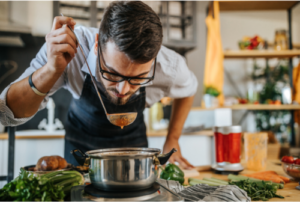
Nope, I’m not talking about taking etiquette classes or studying the classics. We are literally talking about how the flavour of foods are determined and developed. Of course, there’s science backing the nuance and magic of food tasting.
As a food scientist working for major food manufacturers, I discovered a lot about how humans perceive taste and how to measure those perceptions.
If people are asked to compare two dishes and are told that they taste different, most people will perceive a taste difference, even if one doesn’t exist.
In reality, there needs to be about a 25% taste difference between two foods before people can really tell that something has changed.
So how do we determine a 25% taste difference? By using measurement and a spider graph.
When creating a new product or recipe, all the ingredients are carefully measured. Then, as we try to perfect the taste, we will slowly change various flavouring components (e.g. salty, bitter, sweet, umami, herbal, spicy, hot) until we get the perfect flavour. Just like with wine tasting, we identify the different flavours in a food – both the dominant ones, the under tones, and the after tastes.
This is a spider graph showing the dominant flavour profile of common herbs. A spider graph can also be used to chart the overall flavour profile of any food.
The closer to the centre of the graph’s web the dots are, the milder that flavour component is. The farther out to the edge of the graph the dots are, the stronger that flavour component is. You can read the chart to see that coriander has a strong citrus note, but not as strong as with mint.
By the way, if coriander tastes like soap to you, there’s nothing wrong with you or the coriander. “Most cilantro haters shared a particular group of olfactory receptor genes called OR6A2 that has the capacity to identify the smell of aldehyde chemicals that are present in coriander leaves as well as soaps” (The Genetics of Coriander’s Soapy Taste (news-medical.net)).
In upcoming blog posts, I’ll look at the ways we season foods to create new flavour profiles. I’ll discuss herbs, spices, salts, minerals, and microgreens – what they are, and how to use them and store them. And I’ll be sharing recipes that feature fresh new flavour combinations.
It’s going to be delicious so stick around!
Introducing ...Sunny Gold Sweet Mustard Pickles! Dismiss